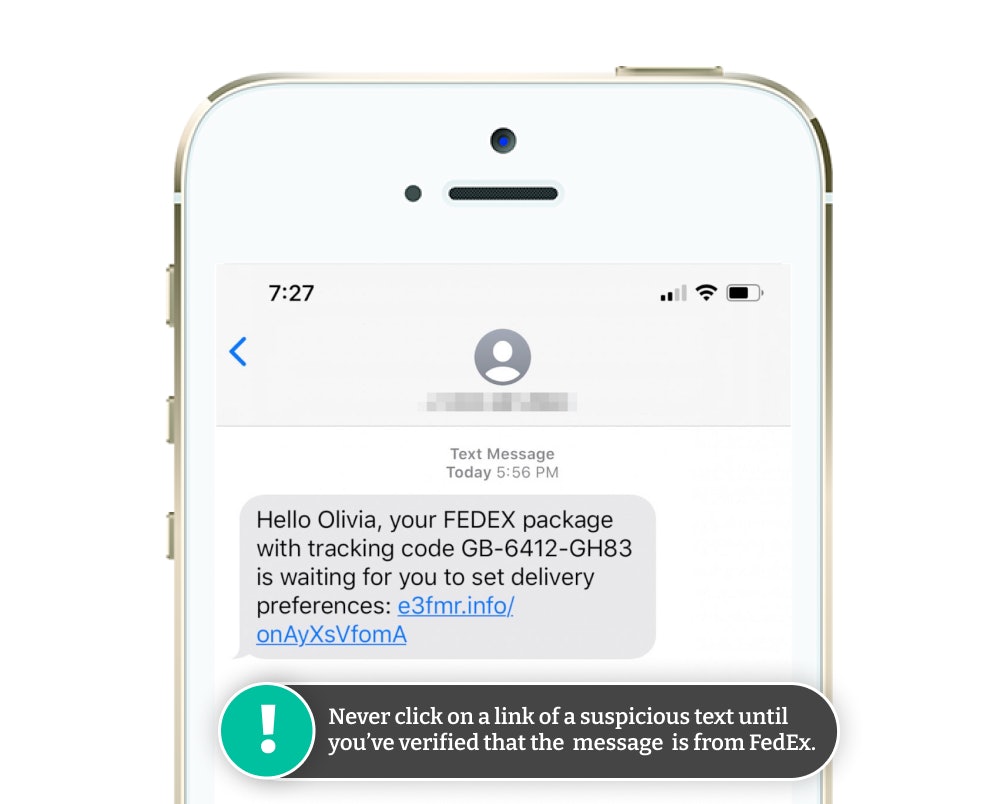- What Types of Texts Does FedEx Send?
- How to Spot a FedEx Text Scam
- How to Avoid FedEx Text Scams
- What to Do If You’ve Fallen for a FedEx Text Scam?
- Frequently Asked Questions
If you received suspicious text messages regarding a delivery or an issue with a package you weren’t expecting, be careful, it may be a FedEx text scam. The shipping company is warning consumers of fraudulent texts being sent to trick them into giving up their personal information. Learn more about this scam, how to protect yourself, and what to do if you accidentally fall for it.
What Types of Texts Does FedEx Send?
Although FedEx does send text alerts and updates to customers, you have to have signed up for these notifications via its Delivery Manager tool. If you have not and you receive a text regarding a delivery, it’s likely a scam.
Further, if you did sign up for these types of updates, it’s important to know that FedEx does not request payment or personal information in return for goods in custody or transit.
How to Spot a FedEx Text Scam
If you know what to look for, you can easily spot a fake FedEx text from a real one. Suspicious text messages may include any of the following:
- Spelling or grammatical errors
- Excessive use of exclamation points
- Unexpected requests for money in return for delivery of a package
- Pushy or urgent requests
- Misspelled or slightly altered website addresses (e.g., fedx.com, fed-ex.com)
One version of this text message scam is below:
Example of a FedEx Scam TextHello Olivia, your FEDEX package with tracking code GB-6412-GH83 is waiting for you to set delivery preferences: e3fmr.info/onAyXsVfomA

How to Avoid FedEx Text Scams
If you’re unsure whether a text claiming it’s from FedEx is a scam, ask yourself the following questions first:
- “Was I expecting a package delivery?”
- “Did I send a package to someone?”
- “Did I sign-up for text notifications?”
If the answer to any of those questions is “no,” then you may be the target of a scam.
Block Scam/Spam Texts
To protect yourself from fake FedEx text messages, stop scam messages from reaching your inbox in the first place. Your messaging app may have an option to block spam/scam texts or you can download an app to do this for you.
Protect Yourself from Fake FedEx Texts
On the chance that you actually are awaiting a package or recently sent one, use the following tips to protect yourself from this text message scam.
- Login to your account via the shipping company’s official website (https://www.fedex.com) to verify whether you have a package waiting for you.
- Call FedEx directly using its Contact Us page. You can find your local customer support line
- Keep in mind that you don’t want to use any phone number provided to you via the text.
- Don’t click on any links within the text as these can be used to install malware onto your device.
- Review the provided tracking number. FedEx’s tracking numbers are typically 12 digits and contain no letter.
- Note, the shipping company sometimes offers 10-, 15-, 20-, and 22-digit numbers.
- Check the tracking number. Type the supposed tracking code into FedEx’s tracking system to see if it’s a legitimate number.
- Don’t copy/paste the code from your phone, though, it may be a phishing link that can be activated if you click it.

It's important to verify links and contact details to beat imposters.
What to Do If You’ve Fallen for a FedEx Text Scam?
If you think you’ve fallen for a FedEx text scam, follow these steps to protect against identity theft and keep your personal information safe:
- Login to your FedEx account and change your password immediately.
- Make sure the new password is a mix of numbers, letters, characters, and avoids real words.
- Screenshot the text and the website (including the URL) and then delete the text.
- Report the text message to FedEx at [email protected].
- Report the incident to the Internet Crime Complaint Center (IC3).
- Copy the message and forward it to 7726 (SPAM).
- Report it to the Federal Trade Commission at ReportFraud.ftc.gov.
Other Types of Scam Texts to Be Aware Of
Scammers are sending more and more scam text messages pretending to be from legitimate companies and banks:
- Amazon
- Amex
- Apple
- AT&T
- Capital One
- Chase
- Citibank
- Citizens Bank
- Fedex
- Navy Federal
- Netflix
- PayPal
- Truist
- UPS
- Venmo
- Verizon
- Walmart
- Wells Fargo
Don't click on links within these texts or call the phone number listed. You should always find the genuine number for the company on their official website.


Comments